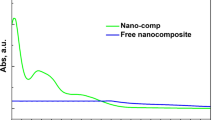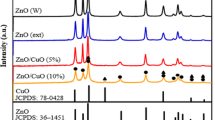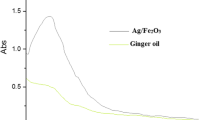Abstract
The present study aims to synthesize and characterize eugenol-loaded nanocomposite (using Syzygium aromaticum), followed by drug loading and analysis of drug release kinetics using standard procedure. UV–Vis spectroscopy showed absorption band at 258 nm, FTIR revealed the availability of eugenol, and SEM analysis and X-ray diffractometer examination revealed average particle diameter of 42.67 nm with orthorhombic structure. Energy dispersive X-ray (EDAX), Zeta, and size distribution pattern also confirmed the elemental composition, formation of stable nanocomposite, and uniformity of synthesized nanocomposite, respectively. MIC value obtained for Escherichia coli, Staphylococcus aureus, and Pseudomonas aeruginosa was 6.25 μg/ml, and for Proteus mirabilis, it is 3.25 μg/ml. MBC value for Escherichia coli and Proteus mirabilis was 12.5 μg/ml, and for Staphylococcus aureus and Pseudomonas aeruginosa, it was 25 μg/ml. Antioxidant studies revealed that Eu@NC showed significant DPPH free radical scavenging activity. This biosynthesized Eu@NC with enhanced antibacterial activity could be less toxic to environment and an eco-friendly approach.
Graphical Abstract
Preparation of powdered clove buds and extraction of phytochemicals, visible changes in the salt solution after addition of plant extract, eugenol loading through Sonicator, characterization and analysis of drug release kinetics, evaluation of antibacterial and antioxidant activity.












Similar content being viewed by others
Data Availability
Not applicable.
References
Nasrollahzadeh, M., Sajadi, S. M., Sajjadi, M., & Issaabadi, Z. (2019). Applications of nanotechnology in daily life. In Interface Science and Technology (Vol. 28, pp. 113–143). https://doi.org/10.1016/B978-0-12-813586-0.00004-3
Patra, J. K., Das, G., Fraceto, L. F., Campos, E. V. R., Rodriguez-Torres, M. D. P., Acosta-Torres, L. S., … Shin, H. S. (2018). Nano based drug delivery systems: Recent developments and future prospects. Journal of Nanobiotechnology 2018 16:1, 16(1), 1–33. https://doi.org/10.1186/S12951-018-0392-8
bhowmik, D., Kumar*, K. P. S., Yadav, A., Srivastava, S., Paswan, S., & Dutta, A. sankar. (2012). Recent trends in Indian traditional herbs Syzygium aromaticum and its health benefits. Journal of Pharmacognosy and Phytochemistry, 1(1), 13–22.
Verma, S. K., Jha, E., Panda, P. K., Kumari, P., Pramanik, N., Kumari, S., & Thirumurugan, A. (2018). Molecular investigation to RNA and protein based interaction induced in vivo biocompatibility of phytofabricated AuNP with embryonic zebrafish. Artificial Cells, Nanomedicine and Biotechnology, 46(sup3), S671–S684. https://doi.org/10.1080/21691401.2018.1505746
Makkar, H., Verma, S. K., Panda, P. K., Pramanik, N., Jha, E., & Suar, M. (2018). Molecular insight to size and dose-dependent cellular toxicity exhibited by a green synthesized bioceramic nanohybrid with macrophages for dental applications. Toxicology Research, 7(5), 959–969. https://doi.org/10.1039/c8tx00112j
Barroso, A., Mestre, H., Ascenso, A., Simões, S., & Reis, C. (2020). Nanomaterials in wound healing: From material sciences to wound healing applications. Nano Select, 1(5), 443–460. https://doi.org/10.1002/NANO.202000055
Husain, S., Nandi, A., Simnani, F. Z., Saha, U., Ghosh, A., Sinha, A., … Verma, S. K. (2023). Emerging trends in advanced translational applications of silver nanoparticles: A progressing dawn of nanotechnology. Journal of Functional Biomaterials, 14(1), 47. https://doi.org/10.3390/jfb14010047
Sarkar, B., Mahanty, A., Gupta, S. K., Choudhury, A. R., Daware, A., & Bhattacharjee, S. (2022). Nanotechnology: A next-generation tool for sustainable aquaculture. Aquaculture, 546, 737330. https://doi.org/10.1016/J.AQUACULTURE.2021.737330
Guo, S., & DiPietro, L. A. (2010). Factors affecting wound healing. Journal of Dental Research, 89(3), 219. https://doi.org/10.1177/0022034509359125
Jiang, T., Li, Q., Qiu, J., Chen, J., Du, S., Xu, X., … Wu, Z. (2022). Nanobiotechnology: Applications in chronic wound healing. International Journal of Nanomedicine, 17, 3125–3145. https://doi.org/10.2147/IJN.S372211
Ramos, A. P., Cruz, M. A. E., Tovani, C. B., & Ciancaglini, P. (2017). Biomedical applications of nanotechnology. Biophysical Reviews 2017 9:2, 9(2), 79–89. https://doi.org/10.1007/S12551-016-0246-2
Khunkitti, W., Veerapan, P., & Hahnvajanawong, C. (2012). In vitro bioactivities of clove buds oil (Eugenia caryophyllata) and its effect on dermal fibroblast. International Journal of Pharmacy and Pharmaceutical Sciences, 4(SUPPL.3), 556–560.
Cortés-Rojas, D. F., de Souza, C. R. F., & Oliveira, W. P. (2014). Clove (Syzygium aromaticum): A precious spice. Asian Pacific Journal of Tropical Biomedicine, 4(2), 90. https://doi.org/10.1016/S2221-1691(14)60215-X
Faiga, N. N., Rachmadi, P., & Meizarini, A. (2018). Neovascular pattern in wound healing after zinc oxide and curcuma longa rhizome extract dressing application. Contemporary Clinical Dentistry, 9(Suppl 2), S337. https://doi.org/10.4103/CCD.CCD_435_18
Sinha, A., Simnani, F. Z., Singh, D., Nandi, A., Choudhury, A., Patel, P., … Verma, S. K. (2022). The translational paradigm of nanobiomaterials: Biological chemistry to modern applications. Materials Today Bio, 17. https://doi.org/10.1016/j.mtbio.2022.100463
Verma, S. K., Suar, M., & Mishra, Y. K. (2022). Editorial: Green perspective of nano-biotechnology: nanotoxicity horizon to biomedical applications. Frontiers in Bioengineering and Biotechnology, 10. https://doi.org/10.3389/fbioe.2022.919226
Prabhu, P., Rao, M., Murugesan, G., Narasimhan, M. K., Varadavenkatesan, T., Vinayagam, R., … Selvaraj, R. (2022). Synthesis, characterization and anticancer activity of the green-synthesized hematite nanoparticles. Environmental Research, 214. https://doi.org/10.1016/j.envres.2022.113864
Selvaraj, R., Pai, S., Vinayagam, R., Varadavenkatesan, T., Kumar, P. S., Duc, P. A., & Rangasamy, G. (2022). A recent update on green synthesized iron and iron oxide nanoparticles for environmental applications. Chemosphere, 308. https://doi.org/10.1016/j.chemosphere.2022.136331
Vinayagam, R., Hebbar, A., Senthil Kumar, P., Rangasamy, G., Varadavenkatesan, T., Murugesan, G., … Selvaraj, R. (2023). Green synthesized cobalt oxide nanoparticles with photocatalytic activity towards dye removal. Environmental Research, 216. https://doi.org/10.1016/j.envres.2022.114766
Vaseghi, Z., Tavakoli, O., & Nematollahzadeh, A. (2018). Rapid biosynthesis of novel Cu/Cr/Ni trimetallic oxide nanoparticles with antimicrobial activity. Journal of Environmental Chemical Engineering, 6(2), 1898–1911. https://doi.org/10.1016/J.JECE.2018.02.038
Alshameri, A. W., & Owais, M. (2022). Antibacterial and cytotoxic potency of the plant-mediated synthesis of metallic nanoparticles Ag NPs and ZnO NPs: A review. OpenNano, 8, 100077. https://doi.org/10.1016/J.ONANO.2022.100077
Verma, S. K., Jha, E., Kiran, K. J., Bhat, S., Suar, M., & Mohanty, P. S. (2016). Synthesis and characterization of novel polymer-hybrid silver nanoparticles and its biomedical study. Materials Today: Proceedings, 3(6), 1949–1957. https://doi.org/10.1016/j.matpr.2016.04.096
Nisar, M. F., Khadim, M., Rafiq, M., Chen, J., Yang, Y., & Wan, C. C. (2021). Pharmacological properties and health benefits of eugenol: A comprehensive review. Oxidative Medicine and Cellular Longevity, 2021. https://doi.org/10.1155/2021/2497354
Kumari, S., kumari, P., Panda, P. K., Pramanik, N., Verma, S. K., & Mallick, M. A. (2019). Molecular aspect of phytofabrication of gold nanoparticle from Andrographis peniculata photosystem II and their in vivo biological effect on embryonic zebrafish (Danio rerio). Environmental Nanotechnology, Monitoring and Management, 11. https://doi.org/10.1016/j.enmm.2018.100201
Rahman, A., Chowdhury, M. A., & Hossain, N. (2022). Green synthesis of hybrid nanoparticles for biomedical applications: A review. Applied Surface Science Advances, 11, 100296. https://doi.org/10.1016/J.APSADV.2022.100296
Chauhan, P. S., Shrivastava, V., & Tomar, R. S. (2018). Biofabrication of copper nanoparticles: A next-generation antibacterial agent against wound-associated pathogens. Turkish Journal of Pharmaceutical Sciences, 15(3), 238–247. https://doi.org/10.4274/tjps.52724
Khan, Z. (2020). Chitosan capped Au@Pd@Ag trimetallic nanoparticles: Synthesis, stability, cap** action and adsorbing activities. International Journal of Biological Macromolecules, 153, 545–560. https://doi.org/10.1016/J.IJBIOMAC.2020.02.304
Sreedharan, S. M., & Singh, R. (2019). Ciprofloxacin functionalized biogenic gold nanoflowers as nanoantibiotics against pathogenic bacterial strains. International Journal of Nanomedicine, 14, 9905–9916. https://doi.org/10.2147/IJN.S224488
Kalam, M. A., Iqbal, M., Alshememry, A., Alkholief, M., & Alshamsan, A. (2022). Fabrication and characterization of tedizolid phosphate nanocrystals for topical ocular application: Improved solubilization and in vitro drug release. Pharmaceutics, 14(7), 1328. https://doi.org/10.3390/PHARMACEUTICS14071328/S1
Khalil, A. A., Rahman, U. U., Khan, M. R., Sahar, A., Mehmood, T., & Khan, M. (2017). Essential oil eugenol: Sources, extraction techniques and nutraceutical perspectives. RSC Advances. https://doi.org/10.1039/c7ra04803c
Nasrollahzadeh, M., Sajjadi, M., Iravani, S., & Varma, R. S. (2020). Trimetallic nanoparticles: Greener synthesis and their applications. Nanomaterials, 10(9), 1784. https://doi.org/10.3390/NANO10091784
Cahyono, B., A’Yun, Q., Suzery, M., & Hadiyanto. (2018). Characteristics of eugenol loaded chitosan-tripolyphosphate particles as affected by initial content of eugenol and their in-vitro release characteristic. IOP Conference Series: Materials Science and Engineering, 349(1). https://doi.org/10.1088/1757-899X/349/1/012010
Muhammad, D. R. A., Tuenter, E., Patria, G. D., Foubert, K., Pieters, L., & Dewettinck, K. (2021). Phytochemical composition and antioxidant activity of Cinnamomum burmannii Blume extracts and their potential application in white chocolate. Food Chemistry, 340, 127983. https://doi.org/10.1016/J.FOODCHEM.2020.127983
Hameed, M., Rasul, A., Waqas, M. K., Saadullah, M., Aslam, N., Abbas, G., … Shah, P. A. (2021). Formulation and evaluation of a clove oil-encapsulated nanofiber formulation for effective wound-healing. Molecules, 26(9). https://doi.org/10.3390/MOLECULES26092491
Paswan, S. K., & Saini, T. R. (2021). Comparative evaluation of in vitro drug release methods employed for nanoparticle drug release studies. Dissolution Technologies, 28(4), 30–38. https://doi.org/10.14227/DT280421P30
Chen, Z., Hu, Y., Li, J., Zhang, C., Gao, F., Ma, X., … Geng, F. (2019). A feasible biocompatible hydrogel film embedding Periplaneta. International Journal of Pharmaceutics, 118707. https://doi.org/10.1016/j.ijpharm.2019.118707
Loo, Y. Y., Rukayadi, Y., Nor-Khaizura, M. A. R., Kuan, C. H., Chieng, B. W., Nishibuchi, M., & Radu, S. (2018). In vitro antimicrobial activity of green synthesized silver nanoparticles against selected Gram-negative foodborne pathogens. Frontiers in Microbiology, 9(JUL), 1–7. https://doi.org/10.3389/fmicb.2018.01555
Mohammed, A., Seid, M. E., Gebrecherkos, T., Tiruneh, M., & Moges, F. (2017). Bacterial isolates and their antimicrobial susceptibility patterns of wound infections among inpatients and outpatients attending the University of Gondar Referral Hospital, Northwest Ethiopia. International Journal of Microbiology, 2017. https://doi.org/10.1155/2017/8953829
Hou, H., Mahdavi, B., Paydarfard, S., Zangeneh, M. M., Zangeneh, A., Sadeghian, N., … Sen, F. (2020). Novel green synthesis and antioxidant, cytotoxicity, antimicrobial, antidiabetic, anticholinergics, and wound healing properties of cobalt nanoparticles containing Ziziphora clinopodioides Lam leaves extract. Scientific Reports, 10(1). https://doi.org/10.1038/S41598-020-68951-X
Chikezie, I. O. (2017). Determination of minimum inhibitory concentration (MIC) and minimum bactericidal concentration (MBC) using a novel dilution tube method. African Journal of Microbiology Research, 11(23), 977–980. https://doi.org/10.5897/ajmr2017.8545
Omara, S. T. (2017). MIC and MBC of honey and gold nanoparticles against methicillin-resistant (MRSA) and vancomycin-resistant (VRSA) coagulase-positive S. aureus isolated from contagious bovine clinical mastitis. Journal of Genetic Engineering and Biotechnology, 15(1), 219–230. https://doi.org/10.1016/j.jgeb.2017.02.010
Woranuch, S., & Yoksan, R. (2013). Eugenol-loaded chitosan nanoparticles: I. Thermal stability improvement of eugenol through encapsulation. Carbohydrate polymers, 96(2), 578–585. https://doi.org/10.1016/J.CARBPOL.2012.08.117
Soltanzadeh, M., Peighambardoust, S. H., Ghanbarzadeh, B., Mohammadi, M., & Lorenzo, J. M. (2021). Chitosan nanoparticles as a promising nanomaterial for encapsulation of pomegranate (Punica granatum l.) peel extract as a natural source of antioxidants. Nanomaterials, 11(6). https://doi.org/10.3390/nano11061439
Bhakya, S., Muthukrishnan, S., Sukumaran, M., & Muthukumar, M. (2016). Biogenic synthesis of silver nanoparticles and their antioxidant and antibacterial activity. Applied Nanoscience (Switzerland), 6(5), 755–766. https://doi.org/10.1007/S13204-015-0473-Z/FIGURES/9
Sarteep, Z., Ebrahimian Pirbazari, A., & Aroon, M. A. (2016). Silver doped TiO2 nanoparticles: Preparation, characterization and efficient degradation of 2,4-dichlorophenol under visible light. Journal of Water and Environmental Nanotechnology, 1(2), 135–144. https://doi.org/10.7508/JWENT.2016.02.007
Mody, V. V., Siwale, R., Singh, A., & Mody, H. R. (2010). Introduction to metallic nanoparticles. Journal of Pharmacy and Bioallied Sciences, 2(4), 282. https://doi.org/10.4103/0975-7406.72127
Verma, S. K., Jha, E., Panda, P. K., Thirumurugan, A., & Suar, M. (2019). Biological effects of green-synthesized metal nanoparticles: A mechanistic view of antibacterial activity and cytotoxicity, 145–171. https://doi.org/10.1007/978-3-030-04477-0_6
Verma, S. K., Panda, P. K., Kumari, P., Patel, P., Arunima, A., Jha, E., … Suar, M. (2021). Determining factors for the nano-biocompatibility of cobalt oxide nanoparticles: Proximal discrepancy in intrinsic atomic interactions at differential vicinage. Green Chemistry, 23(9), 3439–3458. https://doi.org/10.1039/d1gc00571e
Duque-Aristizábal, J. C., Isaza-Areiza, L. M., Tobón-Calle, D., & Londoño-Lopez, M. E. (2019). Antibacterial activity of silver nanoparticles immobilized in zinc oxide-eugenol cement against Enterococcus faecalis: An in vitro study TT - Actividad antibacteriana de nanopartículas de plata inmovilizadas en cemento de óxido de zinc-eugenol contra el. Revista de la Facultad de Odontología Universidad de Antioquia, 30(2), 154–165.
Husain, S., Verma, S. K., Yasin, D., Hemlata, A. Rizvi, M. M., & Fatma, T. (2021). Facile green bio-fabricated silver nanoparticles from Microchaete infer dose-dependent antioxidant and anti-proliferative activity to mediate cellular apoptosis. Bioorganic Chemistry, 107. https://doi.org/10.1016/j.bioorg.2020.104535
Naser, D. K., Abbas, A. K., & Aadim, K. A. (2020). Zeta potential of Ag, Cu, ZnO, CdO and Sn nanoparticles prepared by pulse laser ablation in liquid environment. Iraqi Journal of Science, 61(10), 2570–2581. https://doi.org/10.24996/ijs.2020.61.10.13
Zaichik, S., Steinbring, C., Jelkmann, M., & Bernkop-Schnürch, A. (2020). Zeta potential changing nanoemulsions: Impact of PEG-corona on phosphate cleavage. International Journal of Pharmaceutics, 581(March), 119299. https://doi.org/10.1016/j.ijpharm.2020.119299
Kurpiers, M., Wolf, J. D., Steinbring, C., Zaichik, S., & Bernkop-Schnürch, A. (2020). Zeta potential changing nanoemulsions based on phosphate moiety cleavage of a PEGylated surfactant. Journal of Molecular Liquids, 316, 113868. https://doi.org/10.1016/j.molliq.2020.113868
Loganathan, B., Chandraboss, V. L., Senthilvelan, S., & Karthikeyan, B. (2015). Surface enhanced vibrational spectroscopy and first-principles study of L-cysteine adsorption on noble trimetallic Au/Pt@Rh clusters. Physical Chemistry Chemical Physics, 17(33), 21268–21277. https://doi.org/10.1039/c4cp05170j
Jeyakumar, G. E., & Lawrence, R. (2021). Mechanisms of bactericidal action of eugenol against Escherichia coli. Journal of Herbal Medicine, 26, 100406. https://doi.org/10.1016/j.hermed.2020.100406
Nandiyanto, A. B. D., Oktiani, R., & Ragadhita, R. (2019). How to read and interpret FTIR spectroscope of organic material. Indonesian Journal of Science and Technology, 4(1), 97–118. https://doi.org/10.17509/ijost.v4i1.15806
Bedlovicová, Z., Strapác, I., Baláž, M., & Salayová, A. (2020). A brief overview on antioxidant activity. Molecules, 1–24.
Pohan, L. A. G., Kambiré, O., Nasir, M., & Ouattara, L. (2020). Photocatalytic and antimicrobial properties of [AgTiO 2]:[Clay] nanocomposite prepared with clay different ratios. Modern Research in Catalysis, 09(04), 47–61. https://doi.org/10.4236/MRC.2020.94004
Sardjono, S. A., & Puspitasari, P. (2020). Synthesis and characterization of cobalt oxide nanoparticles using sol-gel method Synthesis and Characterization of Cobalt Oxide Nanoparticles Using Sol-Gel Method, 040046(April), 1–5.
Funding
Self-funded/no external funding.
Author information
Authors and Affiliations
Contributions
Aarya Sahay: writing the manuscript. Rajesh Singh Tomar* contribute to the guidance and correction of the paper, Pallavi Singh Chauhan analyzed the results and designed the methodology of the research work, and Vikas Shrivastava was a role in improving the work. All authors read and approved the final manuscript.
Corresponding author
Ethics declarations
Ethical Approval
Not applicable.
Conflict of Interest
The authors declare no competing interests.
Additional information
Publisher's Note
Springer Nature remains neutral with regard to jurisdictional claims in published maps and institutional affiliations.
Rights and permissions
Springer Nature or its licensor (e.g. a society or other partner) holds exclusive rights to this article under a publishing agreement with the author(s) or other rightsholder(s); author self-archiving of the accepted manuscript version of this article is solely governed by the terms of such publishing agreement and applicable law.
About this article
Cite this article
Sahay, A., Tomar, R.S., Shrivastava, V. et al. Eugenol Loaded Ag-Ti-Co Nanocomposite as a Promising Antimicrobial and Antioxidative Agent. BioNanoSci. 13, 339–351 (2023). https://doi.org/10.1007/s12668-023-01093-2
Accepted:
Published:
Issue Date:
DOI: https://doi.org/10.1007/s12668-023-01093-2




